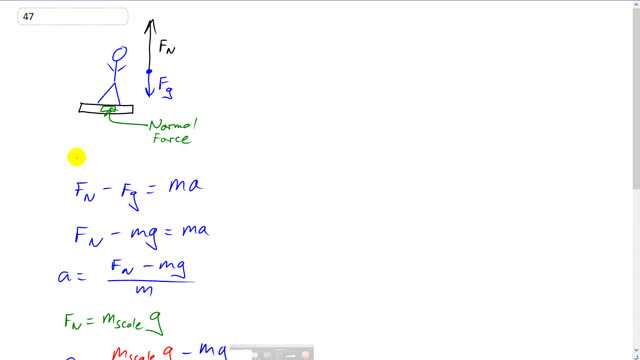
You know your mass is 62 kg, but when you stand on a bathroom scale in an elevator, it says your mass is 77 kg. What is the acceleration of the elevator, and in which direction?

In order to watch this solution you need to have a subscription.
This is Giancoli Answers with Mr. Dychko. Here's a free-body diagram if you are standing on a scale. There's a normal force going upwards and gravity pointing down. And the scale is built so that it gives you correct reading for your mass if you are moving at constant speed or you are at rest, which, you know, you are whenever you stand on a bathroom scale. Except in this very special case of being in an elevator in which case, you could be accelerating vertically. So, when you do that, the scale isn't built to account for that and so, it just blindly tells you what the normal force is pushing upwards; although it converts that normal force into kilograms, with the assumption that you are on Earth and using 9.8 meters per second squared as the gravitational field strength. So, anyway, let's write down Newton's second law, based on this free-body diagram; we have normal force upwards and we are taking up to be the positive direction minus gravity equals mass times acceleration because it's the net force. And force of gravity is mg, where m is your true mass of 62 kilograms and g is the acceleration due to gravity or gravitational field strength. We can divide both sides by m and then switch the sides around so we have acceleration equals normal force minus mg over m. The normal force is the apparent mass, shown in the scale, times by g, 9.8 newtons per kilograms because that's what the scale is going to be calibrated for and we'll substitute that in for normal force. And that's what's written here. And we can factor out the g. And so we have the acceleration is 9.8 meters per second squared times 77 kilograms—mass measured by the scale— minus the 62 kilograms—true mass— divided by 62 gives 2.4 meters per second squared and that's in the upper direction because this is a positive acceleration, and we chose upwards to be the positive direction.